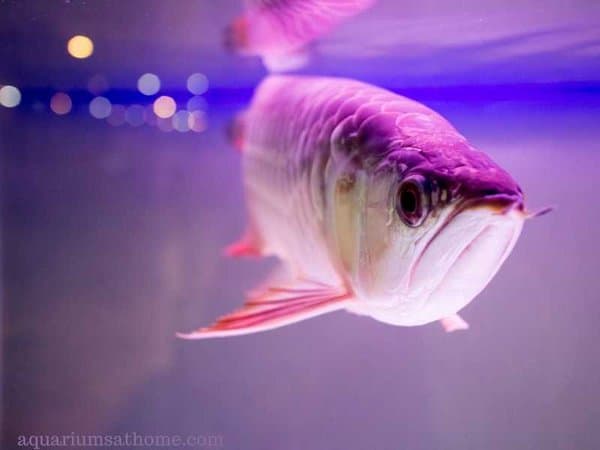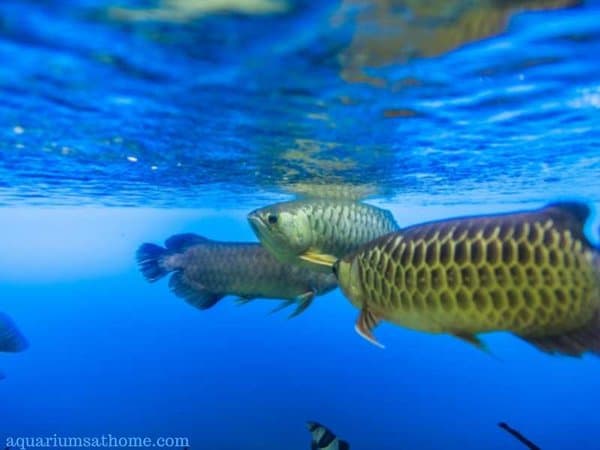Arowanas are a type of freshwater fish with an elongated body and bony tongue. Typically referred to as ‘monster fish,’ this species can grow to a whopping 4 feet in length and has a very large body with a huge mouth. They’re massive by aquarium fish standards and require the care of an experienced aquarist. If you have arowanas, you may be wondering what to do to reduce fish stress in captivity?
To reduce Arowana fish stress, change the water routinely, check the parameters regularly, have a well-functioning filtration system, upsize your tank, ensure your tank has plenty of coverage, make sure all fish are compatible, remove aggressive tankmates, and feed fish adequately.
Now that you know what it takes to keep Arowana fish stress-free in a contained environment, let’s explore this topic further. Together we’ll learn what causes fish stress in captivity, how to recognize the symptoms of stress, how to prevent and/or reduce it, whether (or not) stressed fish can recover, and how to treat a stressed fish?
So, if you’re ready to ‘dive deeper’ into the aquatic world of the arowana fish and learn how to keep them happy and healthy in captivity, then let’s get started!
How do I know if My Arowana is Stressed?
To determine if your pet arowanas are stressed, watch for the following symptoms:
- erratic swimming or darting/flitting around the tank
- hiding for long periods of time
- laying motionless along the substrate
- gasping for air at the surface
- ‘flashing’ – scraping against rocks or gravel
- loss of appetite
- change in coloration
- white patches or lesions on fins or gills
*At the first sign of fish stress, it’s imperative that you start troubleshooting to determine where the problem lies. Once you figure out the root cause of the anxiety, you can begin to fix/treat it.
What Causes Arowana Fish Stress?
Arowana fish stress is typically the result of the following:
- increased ammonia levels in the water
- inadequate aeration or lack of oxygen
- fluctuations in temperature and/or pH
- lack of coverage or hiding places
- aggressive and/or territorial tankmates
- a too small or overstocked aquarium
- malnutrition or lack of food
- parasitic infection or disease
*Be observant of your tank – watch the behavior of your fish daily to ensure they’re no problems. As an aquarist, the safety and health of your pet arowanas is your number one concern.

What are the Ways to Reduce Arowana Fish Stress?
There are 8 ways to reduce arowana fish stress in captivity. These include the following:
Change the Water Routinely
Regular tank maintenance is required to reduce fish stress. For large, messy fish that produce a lot of waste (like arowanas), you should do weekly partial water changes of at least 25% to reduce nitrate levels and keep the aquatic environment clean, safe, and free of toxic ammonia.
Check the Water Parameters Regularly
Monitoring the temperature, pH, and hardness of the aquarium water is key to reducing fish stress. Arowanas require a warm aquatic environment (between 75- and 85-degrees Fahrenheit) with a pH ranging from 5.5 to 7.5, and a hardness factor of 1 to 8 dKH.
Upgrade Your Filtration System
Ensuring you have a high-quality, electrically powered filter is essential to minimizing arowana fish stress. This species is massive and produces a ton of excess waste. A top-notch filtration system will help eliminate both bacteria and debris while improving oxygenation in the water.
Upsize Your Tank
Making sure your tank is big enough is essential to reducing stress in arowana fish. The minimum size for this huge fish is 180 gallons – and that’s for just a single adult! Juveniles can start out in a 60-gallon tank, but they grow quickly (around 2 inches per month) so you need to be ready and willing to upsize.
Provide Coverage and/or Hiding Places
Providing a few hiding places for stressed fish to retreat to will help reduce stress. In terms of arowanas, you can add some floating plants – anything at the bottom of the tank is of no use to this species since they spend most of their time in the top half of an aquarium.
Ensure All Fish are Compatible
Introducing compatible tankmates is key to minimizing fish stress. Arowanas typically ignore other fish and can live with moderately aggressive cichlids such as green terrors, parrots, and Jack Dempseys. They also do well with bottom dwellers like loaches since they occupy a separate area of the aquarium.
Remove Aggressive Tankmates
Rehome aggressive tankmates to a separate tank When feeding, the Arowanas are only mildly hostile, but they normally ignore other tank mates. They are compatible alongside cichlids and moderately aggressive fish due to their ability to defend themselves with their strong scales.
Feed Fish Adequately
Feeding arowanas enough of the ‘right’ food is key to reducing stress. This species is carnivorous and requires live or frozen edibles including shrimp, worms, and insects. They need to be fed 2-3 times per day but make sure not to overfeed as this can lead to obesity and swim bladder disease.
How do I Keep My Arowana Fish Happy?
To keep arowana fish happy, you must ensure they have an extra-large tank (180-gallons minimum for a single fish with an extra 100-gallons for each additional fish). Maintaining the proper water conditions and keeping the tank clean are essential. Make sure the tank has a lid as they’re excellent jumpers!
Feeding arowanas a protein-rich diet is a must as well as housing them with compatible tankmates. Fresh, oxygenated water will also help make them happy and healthy. Add a bubbler for ‘fun’ and to help keep the tank well-aerated.

Can You Keep Arowana Fish in a Pond?
Arowanas will do very well in a tropical pond since it more closely resembles their natural habitat. They can adapt to varying water conditions and will thrive in such a large aquatic environment. The more space they have to explore and forage freely, the happier and healthier they’ll be.
As well, the combination of plenty of swimming space, natural sunlight, and live foods (insects, tiny crustaceans, etc.) are like those of the mud ponds in Singapore where the best arowanas are raised prior to being shown. When it comes to arowana fish, the bigger the aquatic environment, the better!
Can a Stressed Arowana Fish Recover?
A stressed arowana fish can recover, provided it hasn’t become terminally ill. Parasitic diseases such as fish lice or anchor worms can cause premature death if not treated promptly. Droop eye syndrome is a common illness which causes eyeballs to tilt downwards. The severity is based on the degree of eye tilt.
To nurse a sick arowana fish, try a salt bath stress treatment. Measure out 1 teaspoon of non-iodized (rock or kosher) salt for every gallon of water in the tank. Using a container, dissolve the salt completely in a small amount of tank water and then slowly add the salt solution to the tank.
Final Thoughts
To sum-up, reducing arowana fish stress requires you do the following: change the water weekly, check the parameters routinely, install a well-functioning, high-quality filter, upsize your tank if too small, make sure your tank has coverage, ensure all tank inhabitants are compatible, remove any aggressive fish, and feed fish regularly and adequately.
I trust this article has answered your questions regarding Arowana fish and how to reduce stress in captivity. Thanks for reading – good luck and happy fish keeping!
Recommended Posts
Are Asian Arowana Fish Legal to Own?
Why is Arowana so Expensive? [They Cost How Much?!]
What do You Feed an Arowana? [The Dragon Fish]




